The global ingestible sensors market is estimated to be valued at USD 747.8 Mn in 2025 and is expected to reach USD 1,826.8 Mn by 2032, exhibiting a compound annual growth rate (CAGR) of 13.6% from 2025 to 2032.
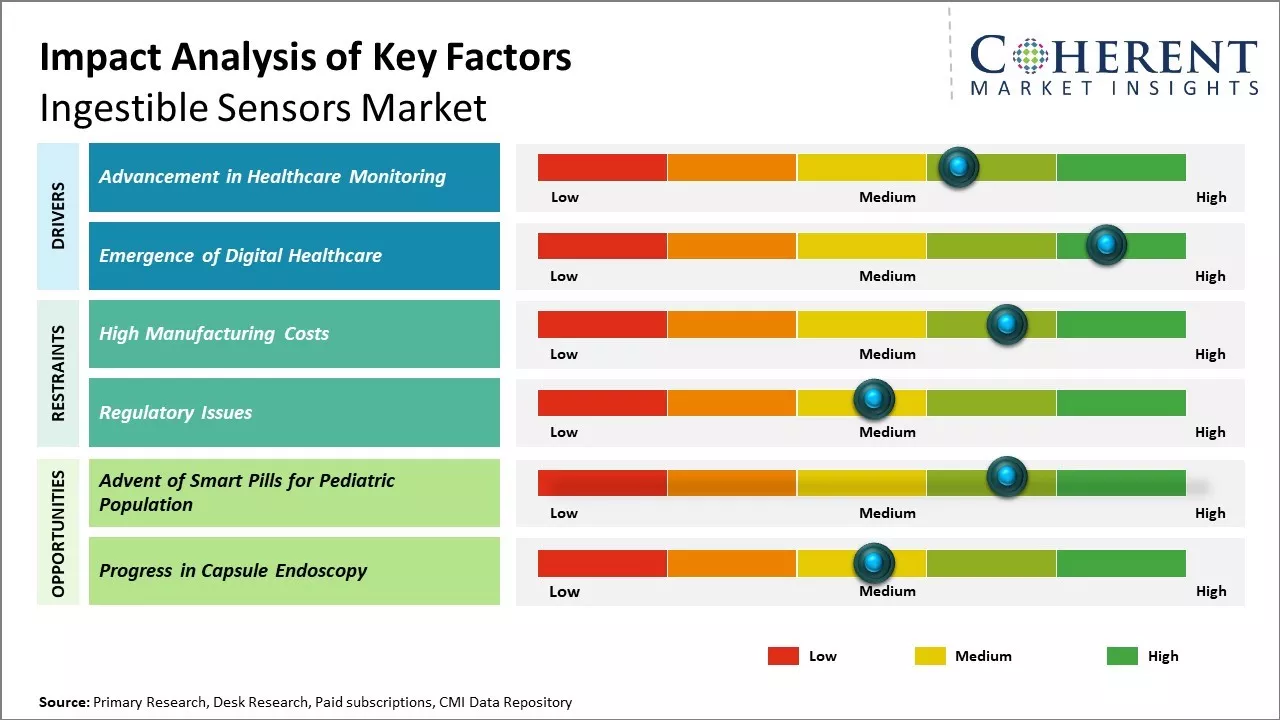
Discover market dynamics shaping the industry: Request sample copy
The growing prevalence of chronic diseases and increasing demand for continuous monitoring of health-related parameters are expected to boost the adoption of ingestible sensors. Further, technological advancements in microelectromechanical (MEMS) and wireless technologies have enabled the development of miniaturized and precision-based ingestible sensors. This has increased their applications for monitoring various physiological parameters related to gastrointestinal health, endoscopy, drug delivery, and nutrition management. Also, increasing investments by market players for the development of novel ingestible sensor-based devices and government support are further expected to drive the market growth during the forecast period.
Advancement in Healthcare Monitoring
The global population is aging at an unprecedented rate which has increased the burden on healthcare systems worldwide. This has fueled the demand for innovative diagnostic and monitoring solutions that can help provide care for the growing elderly population. Ingestible sensors are revolutionizing how care can be provided as they allow for continuous monitoring of vital health parameters from inside the body in a minimally invasive manner. The sensors can transmit real-time data on metrics like temperature, pH levels, and biomarkers which can help detect the onset of diseases at an early stage and also enable remote monitoring of patients. This brings about greater convenience as it eliminates the need for frequent hospital or doctor visits. The technology is also beneficial for monitoring patients with chronic conditions and tracking treatment progress. As people are living longer with complex health issues, ingestible sensors can play a vital role in enhancing health outcomes in a cost-effective way without compromising on care quality. Their use could help manage rising healthcare expenditures by facilitating early detection and preventive care. Several startups and big tech companies are ramping up research to expand the capabilities of these sensors. This is expected to make them more accurate and allow monitoring of additional biomarkers which will further cement their importance within the evolving healthcare ecosystem.
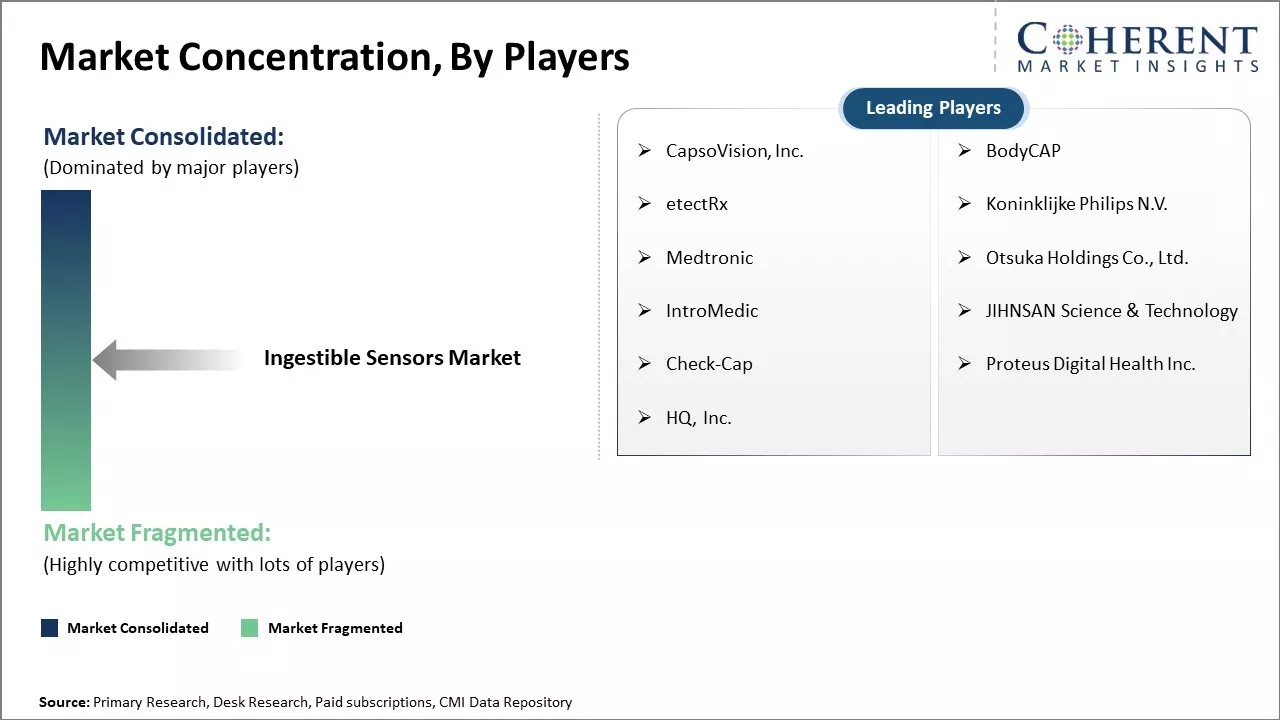
Get actionable strategies to beat competition: Request sample copy
Emergence of Digital HealthcareDigital technologies have transformed various aspects of modern life and healthcare is one sector that has been experiencing a paradigm shift. There is a growing trend of patients actively taking charge of their health and wellness through self-monitoring devices and apps. This has been driven by the ubiquitous availability of smartphones and other connected devices. Consumers are more health-conscious and prefer convenient options for tracking metrics and sharing data with doctors. At the same time, COVID-19 has shifted healthcare delivery towards telehealth and remote monitoring. This has created opportunities for digital health solutions like ingestible sensors that can facilitate virtual care. As patients seek contactless options, these sensors are well-positioned to monitor health from home in real-time. Leveraging the cloud and connectivity platforms, the collected data can also be seamlessly integrated with electronic health records. This allows multi-disciplinary care teams to collaborate efficiently and optimize treatment plans. Major technology giants are investing heavily in digital healthcare aimed at empowering consumers and making services more accessible through networked solutions. Ingestible sensors perfectly align with this vision of connected care and the digital transformation of the industry is set to further fuel their adoption.
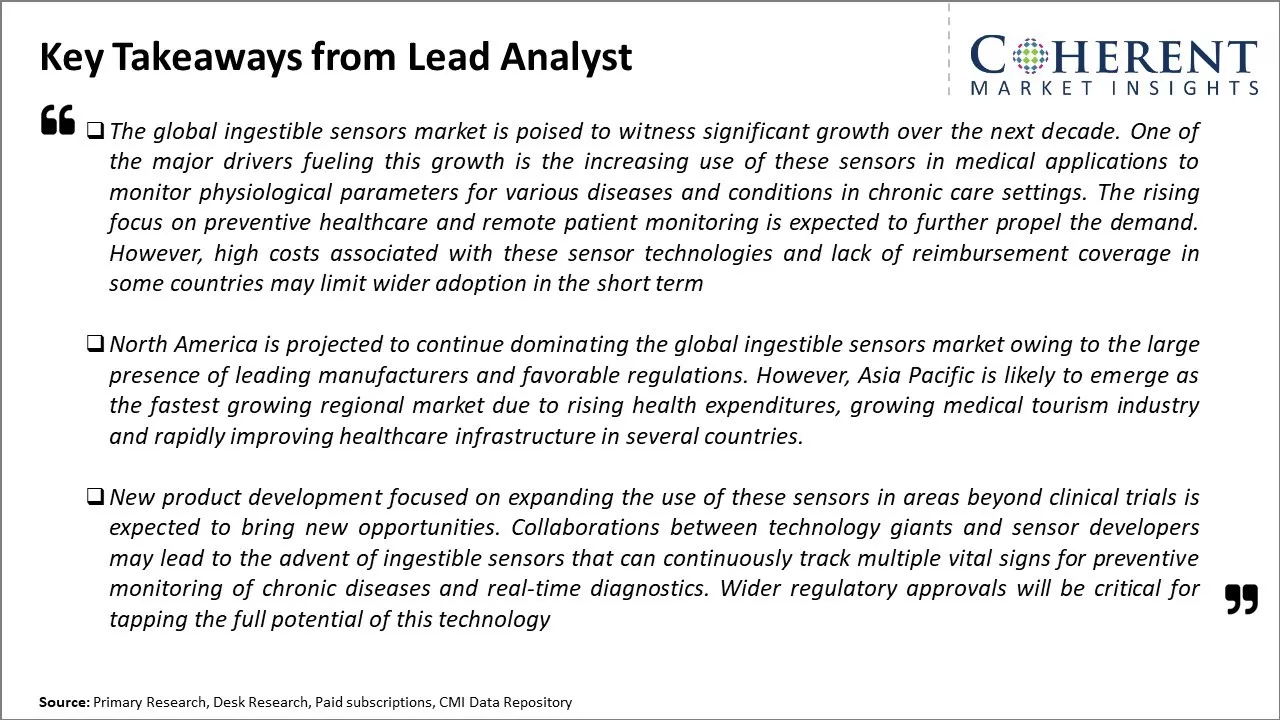
To learn more about this report, Request sample copy
Market Challenges – Regulatory IssuesRegulatory issues across different countries are one of the major restraining factors for the growth of the global ingestible sensors market. Ingestible sensors are tiny ingestible electronic devices that can be swallowed and then pass through the digestive system, providing physiological data from inside the body. However, stringent regulations involving products related to medical devices and health have made approval processes very lengthy and complex for ingestible sensors. Various countries have their own regulatory requirements and approval processes to ensure safety and efficacy of medical devices before they can be commercialized. For example, in the U.S., the Food and Drug Administration (FDA) classifies ingestible sensors as medical devices and regulates them under different categories based on the associated risks. Getting approval involve extensive clinical trials and testing which can delay market launch by several years. Similarly, the European Medical Agency (EMA) also has strict norms where new medical devices need to comply with EU Medical Device Regulation to gain CE marking before they can be sold in European countries. Complying with varied regulations across different markets lengthens the time taken to commercially release these sensors.
Market Opportunities – Progress in Capsule Endoscopy
Capsule endoscopy involves patients swallowing a small camera capsule that takes thousands of pictures of the digestive tract as it travels through. This non-invasive procedure allows physicians to detect diseases like celiac disease, Crohn's disease, and small intestinal cancers more effectively compared to other usual diagnostic tests. The technology behind capsule cameras has advanced significantly in recent years, with improvements in image resolution, larger data storage capacity and options for control over the camera. Newer capsule endoscopes feature magnets that allow doctors to control the movement of the capsule using an external device. This provides the ability to stop, start or change the direction of the capsule when required. Some capsules can also release medications at targeted locations or take biopsies using detachable multipurpose tools. With continuing technological developments, future capsules may be embedded with sensors to detect biomarkers in real-time and transmit the results. This would enable continuous monitoring of diseases and timely interventions. The decreasing size of electronic components has made it possible to pack more advanced capabilities into tiny ingestible sensors.
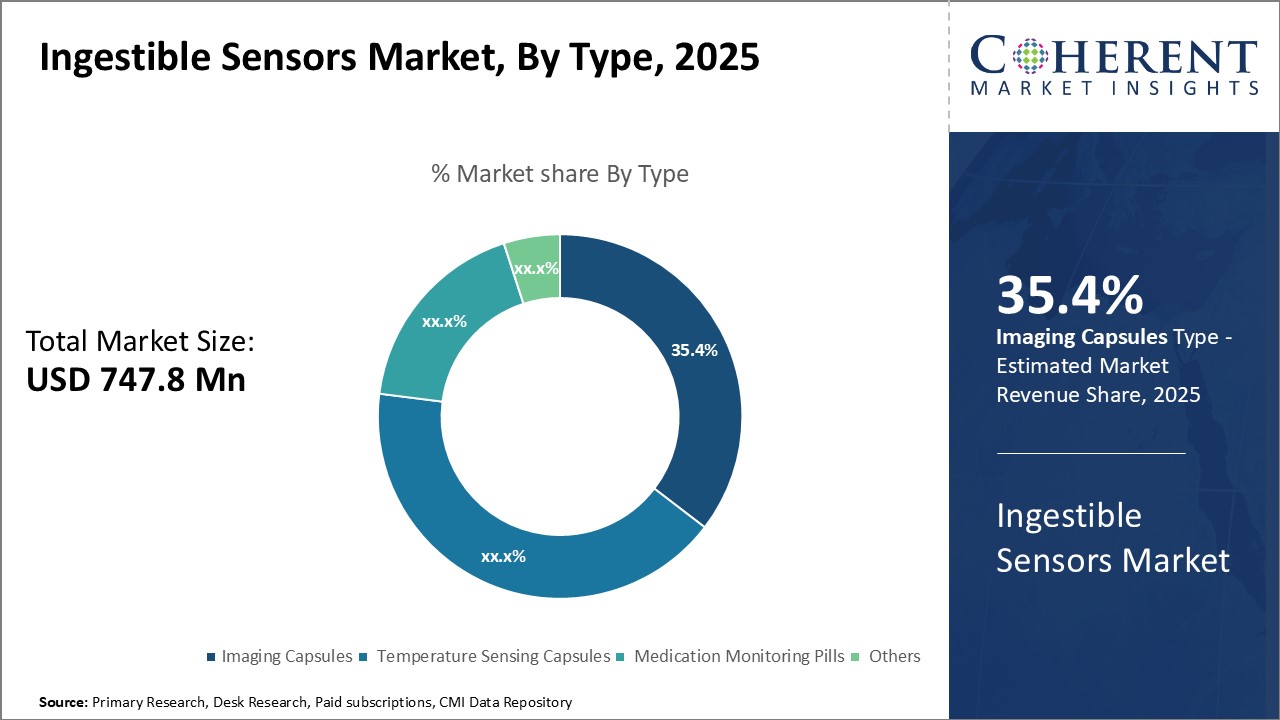
Discover high revenue pocket segments and roadmap to it: Request sample copy
Insights, By Type: Advancements in Endoscopy TechnologyThe type segment includes imaging capsules, temperature sensing capsules, medication monitoring pills, others. The imaging capsules sub-segment is estimated to hold 35.4% of the market share in 2025. Imaging capsules have seen rising adoption rates in recent years due to their non-invasive nature and ability to capture high quality images from anywhere within the gastrointestinal tract. As these capsules pass through the digestive system, they are able to transmit thousands of images wirelessly to monitoring devices worn by patients. This allows physicians to detect conditions like celiac disease, Crohn's disease, and tumors without the discomfort of traditional endoscopic procedures. Technological improvements have played a key role in driving the growth of imaging capsules. Newer capsules are equipped with higher resolution cameras and longer battery lives, enabling clearer diagnosis. Some capsules can stay active for up to 12 hours after ingestion. Advancements in wireless transmission have also increased data transfer speeds and image quality. Miniaturization trends continue to make capsules smaller and easier to swallow. New SmartPill capsules even incorporate pH, pressure and temperature sensors in addition to imaging.
Insights, By End-use: Need for Non-invasive Diagnostics
The end-use segment includes healthcare, sports & fitness, and others. The healthcare sub-segment is estimated to hold 33.6% of the market share in 2025 due to the growing emphasis on non-invasive diagnosis and monitoring within the industry. Conditions affecting the digestive system are highly prevalent but often require examination of the entire gastrointestinal tract. Imaging capsules and other ingestible sensors address this need by enabling visualization from inside without surgical procedures. They significantly reduce discomfort for patients and procedure time for clinicians compared to endoscopies. This improves diagnostics for troublesome issues like internal bleeding, ulcers and inflammation. Healthcare providers are also under constant pressure to enhance efficiency and reduce costs. Ingestible sensors help optimize resource usage within hospitals and diagnostic centers. They can be administered by trained nurses rather than specialists, freeing up expert time. Early detection of issues via frequent mass screening also cuts down on future advanced treatment requirements.
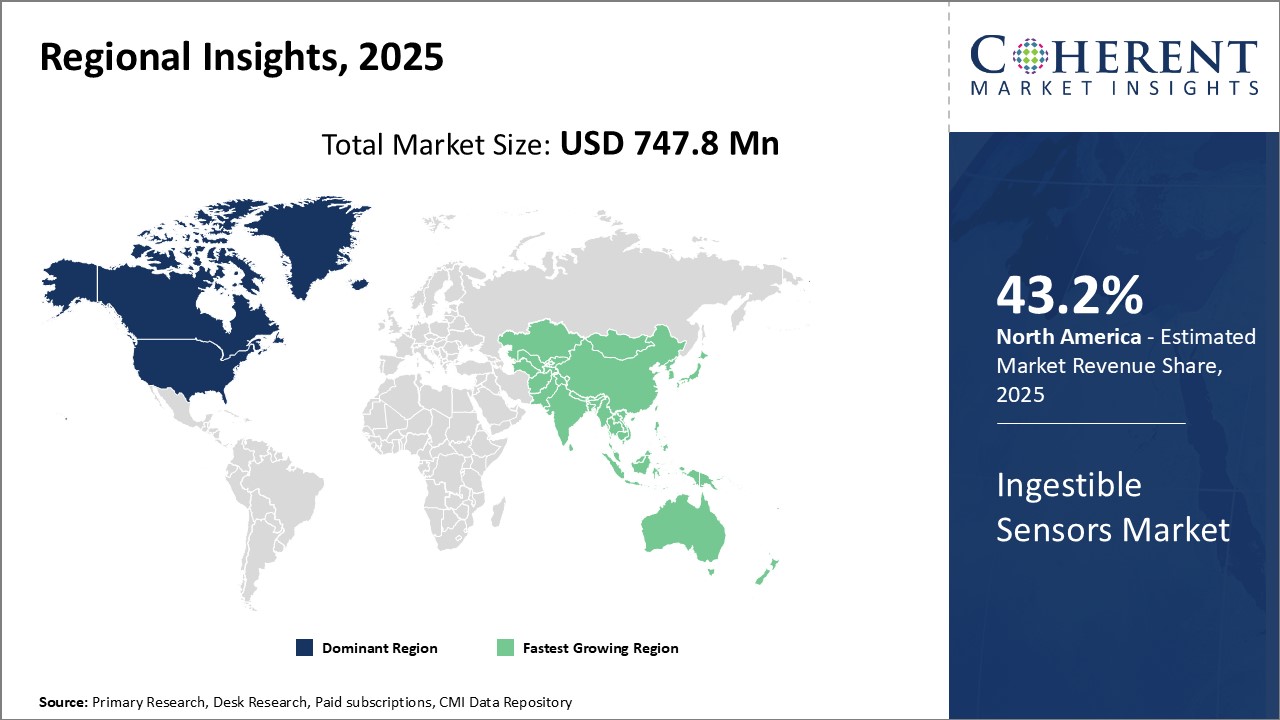
Need a Different Region or Segment? Customize now
North America remains the dominant region in the global ingestible sensors market and is estimated to hold 43.2% of the market share in 2025. The region has a well-established healthcare infrastructure with large healthcare spending per capita. Many of the leading technology companies involved in developing ingestible sensor technologies are headquartered in the U.S. This has created a strong innovation ecosystem which drives rapid advancements in the space. Additionally, favorable reimbursement policies and awareness among healthcare providers as well as consumers has led to high adoption rates of these next generation medical devices. The region is also a major exporter of these devices to other developed markets. However, pricing pressures from payers are forcing companies to look at reducing production costs.
The Asia Pacific region has emerged as the fastest growing market for ingestible sensors in recent years. Countries such as China, India, Japan, and South Korea are contributing significantly to the Asia Pacific market growth. This growth can be attributed to factors like rising healthcare expenditure, growing medical tourism industry, and increasing occurrence of chronic diseases in the region. The large patient pool and focus on developing home healthcare solutions are further propelling the Asia Pacific ingestible sensors market. The presence of several contract manufacturing organizations have made this region an attractive production base for global players looking to reduce overhead costs. Regional players are also making efforts to develop low-cost sensor solutions tailored for the price-sensitive APAC markets. Exporting to other developing Asian and African countries present lucrative opportunities. The market is expected to continue on its high growth trajectory in the coming years.
Ingestible Sensors Market Report Coverage
| Report Coverage | Details | ||
|---|---|---|---|
| Base Year: | 2024 | Market Size in 2025: | USD 747.8 Mn |
| Historical Data for: | 2020 To 2024 | Forecast Period: | 2025 To 2032 |
| Forecast Period 2025 to 2032 CAGR: | 13.6% | 2032 Value Projection: | USD 1,826.8 Mn |
| Geographies covered: |
|
||
| Segments covered: |
|
||
| Companies covered: |
CapsoVision, Inc., BodyCAP, etectRx, Koninklijke Philips N.V., Medtronic, Otsuka Holdings Co., Ltd., IntroMedic, JIHNSAN Science & Technology, Check-Cap, Proteus Digital Health Inc., and HQ, Inc. |
||
| Growth Drivers: |
|
||
| Restraints & Challenges: |
|
||
Uncover macros and micros vetted on 75+ parameters: Get instant access to report
*Definition: Ingestible sensors are electronic devices or sensors in the form of pills or capsules that can be swallowed and pass through the gastrointestinal tract. These ingestible sensors once ingested can transmit physiological and environmental data from inside the body to an external monitoring device via wireless communication. They help in monitoring bodily functions and detecting medical conditions from within the body without any surgical procedures.
Share
Share
About Author
Komal Dighe is a Management Consultant with over 8 years of experience in market research and consulting. She excels in managing and delivering high-quality insights and solutions in Health-tech Consulting reports. Her expertise encompasses conducting both primary and secondary research, effectively addressing client requirements, and excelling in market estimation and forecast. Her comprehensive approach ensures that clients receive thorough and accurate analyses, enabling them to make informed decisions and capitalize on market opportunities.
Missing comfort of reading report in your local language? Find your preferred language :
Transform your Strategy with Exclusive Trending Reports :
Frequently Asked Questions
Joining thousands of companies around the world committed to making the Excellent Business Solutions.
View All Our Clients
US Reciprocal Tax Impact Analysis On Ingestible Sensors Market
Stay updated on tariff changes with expert insights and timely information